Wireless Networking and Communication Assignment - MITS5003, 2019
VerifiedAdded on 2022/09/09
|9
|1291
|14
Homework Assignment
AI Summary
This document presents a comprehensive solution to a wireless networks and communication assignment (MITS5003), addressing various aspects of networking principles. The solution begins by illustrating communication between a server and workstation using TCP/IP protocol, routers, and IEEE 802 LANs. It then proceeds to solve problems involving sinusoidal waveforms, calculating amplitude, phase angle, frequency, and evaluating waveforms. Furthermore, the assignment delves into channel capacity calculations, considering SNR and bandwidth, as well as data rate analysis. The document also explores the differences between circuit switching and packet switching, highlighting their respective strengths and weaknesses. Finally, the solution includes the calculation of antenna heights based on distance and signal propagation characteristics, referencing relevant literature to support the analysis. This assignment provides a valuable resource for students studying wireless networks and communication.

NETWORKING 0
Wireless networking and communication
Wireless networking and communication
Paraphrase This Document
Need a fresh take? Get an instant paraphrase of this document with our AI Paraphraser
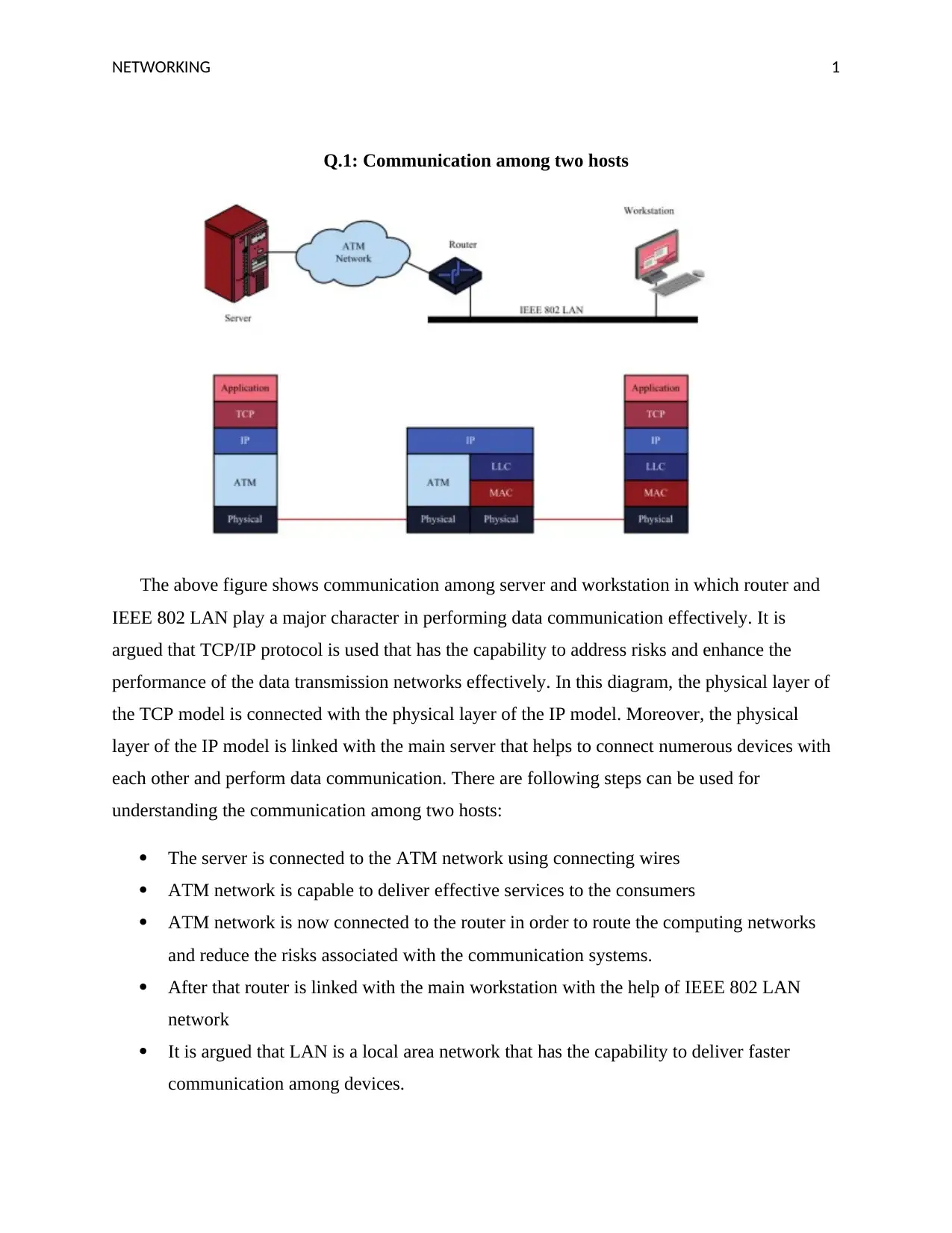
NETWORKING 1
Q.1: Communication among two hosts
The above figure shows communication among server and workstation in which router and
IEEE 802 LAN play a major character in performing data communication effectively. It is
argued that TCP/IP protocol is used that has the capability to address risks and enhance the
performance of the data transmission networks effectively. In this diagram, the physical layer of
the TCP model is connected with the physical layer of the IP model. Moreover, the physical
layer of the IP model is linked with the main server that helps to connect numerous devices with
each other and perform data communication. There are following steps can be used for
understanding the communication among two hosts:
The server is connected to the ATM network using connecting wires
ATM network is capable to deliver effective services to the consumers
ATM network is now connected to the router in order to route the computing networks
and reduce the risks associated with the communication systems.
After that router is linked with the main workstation with the help of IEEE 802 LAN
network
It is argued that LAN is a local area network that has the capability to deliver faster
communication among devices.
Q.1: Communication among two hosts
The above figure shows communication among server and workstation in which router and
IEEE 802 LAN play a major character in performing data communication effectively. It is
argued that TCP/IP protocol is used that has the capability to address risks and enhance the
performance of the data transmission networks effectively. In this diagram, the physical layer of
the TCP model is connected with the physical layer of the IP model. Moreover, the physical
layer of the IP model is linked with the main server that helps to connect numerous devices with
each other and perform data communication. There are following steps can be used for
understanding the communication among two hosts:
The server is connected to the ATM network using connecting wires
ATM network is capable to deliver effective services to the consumers
ATM network is now connected to the router in order to route the computing networks
and reduce the risks associated with the communication systems.
After that router is linked with the main workstation with the help of IEEE 802 LAN
network
It is argued that LAN is a local area network that has the capability to deliver faster
communication among devices.
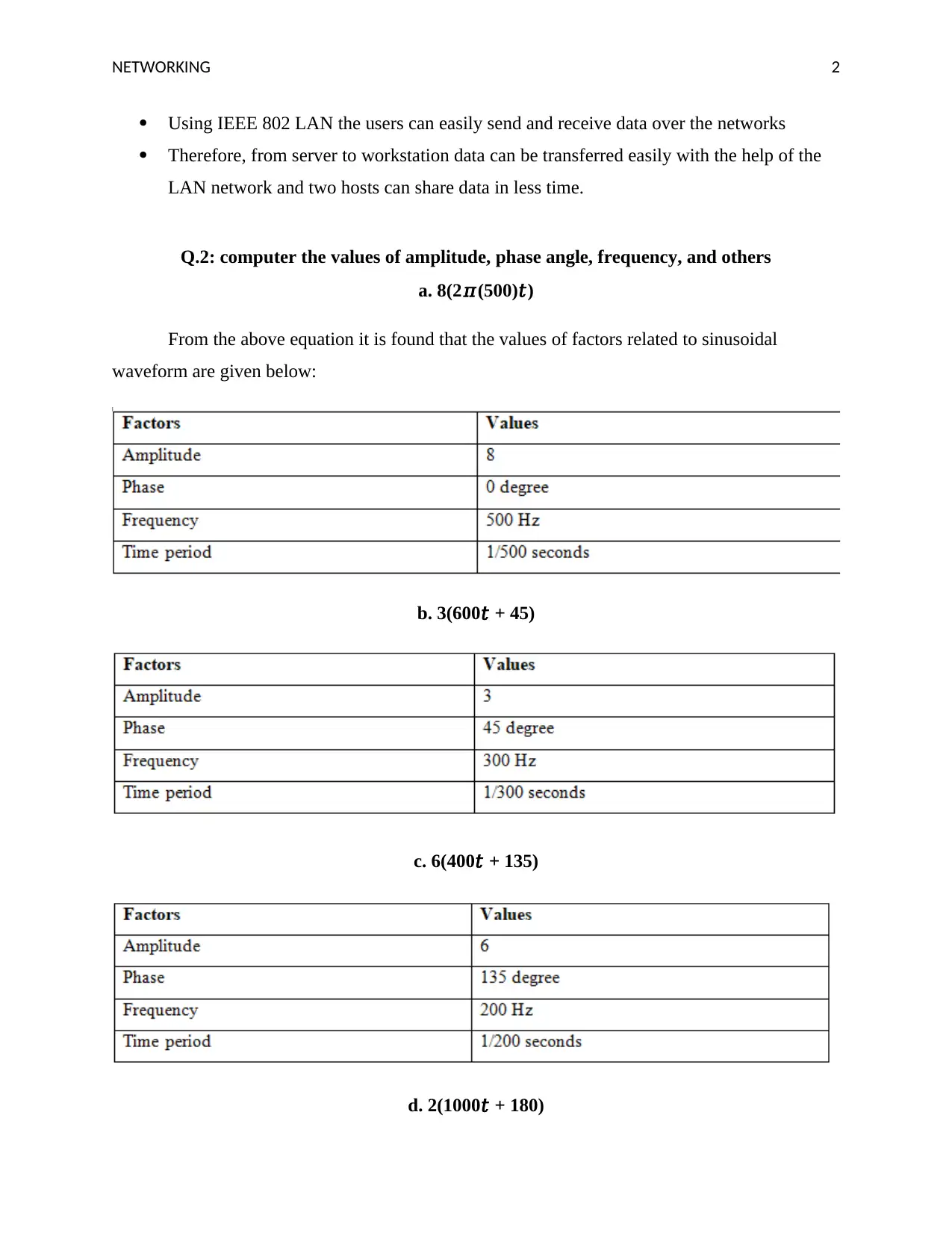
NETWORKING 2
Using IEEE 802 LAN the users can easily send and receive data over the networks
Therefore, from server to workstation data can be transferred easily with the help of the
LAN network and two hosts can share data in less time.
Q.2: computer the values of amplitude, phase angle, frequency, and others
a. 8(2𝜋(500)𝑡)
From the above equation it is found that the values of factors related to sinusoidal
waveform are given below:
b. 3(600𝑡 + 45)
c. 6(400𝑡 + 135)
d. 2(1000𝑡 + 180)
Using IEEE 802 LAN the users can easily send and receive data over the networks
Therefore, from server to workstation data can be transferred easily with the help of the
LAN network and two hosts can share data in less time.
Q.2: computer the values of amplitude, phase angle, frequency, and others
a. 8(2𝜋(500)𝑡)
From the above equation it is found that the values of factors related to sinusoidal
waveform are given below:
b. 3(600𝑡 + 45)
c. 6(400𝑡 + 135)
d. 2(1000𝑡 + 180)
⊘ This is a preview!⊘
Do you want full access?
Subscribe today to unlock all pages.

Trusted by 1+ million students worldwide
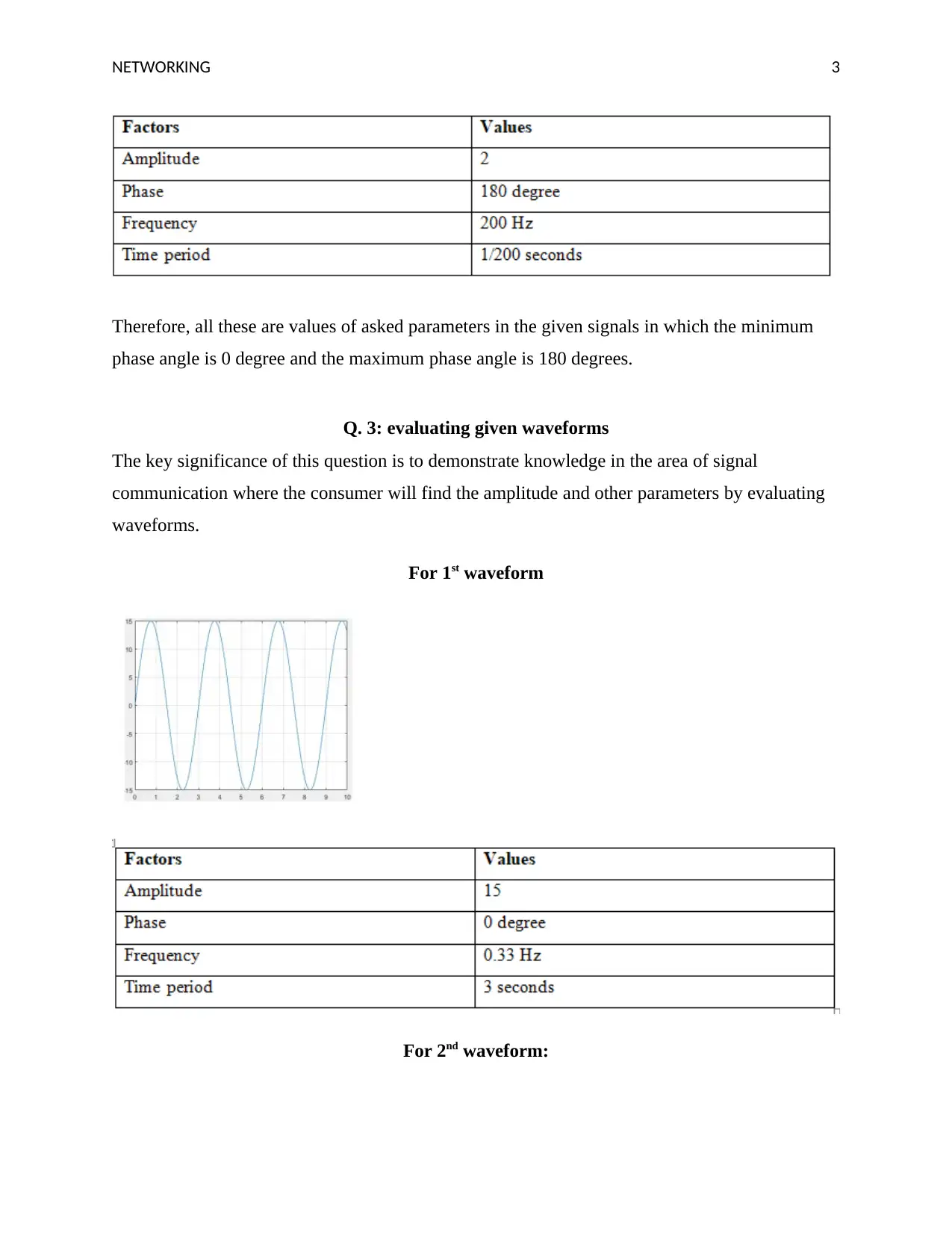
NETWORKING 3
Therefore, all these are values of asked parameters in the given signals in which the minimum
phase angle is 0 degree and the maximum phase angle is 180 degrees.
Q. 3: evaluating given waveforms
The key significance of this question is to demonstrate knowledge in the area of signal
communication where the consumer will find the amplitude and other parameters by evaluating
waveforms.
For 1st waveform
For 2nd waveform:
Therefore, all these are values of asked parameters in the given signals in which the minimum
phase angle is 0 degree and the maximum phase angle is 180 degrees.
Q. 3: evaluating given waveforms
The key significance of this question is to demonstrate knowledge in the area of signal
communication where the consumer will find the amplitude and other parameters by evaluating
waveforms.
For 1st waveform
For 2nd waveform:
Paraphrase This Document
Need a fresh take? Get an instant paraphrase of this document with our AI Paraphraser
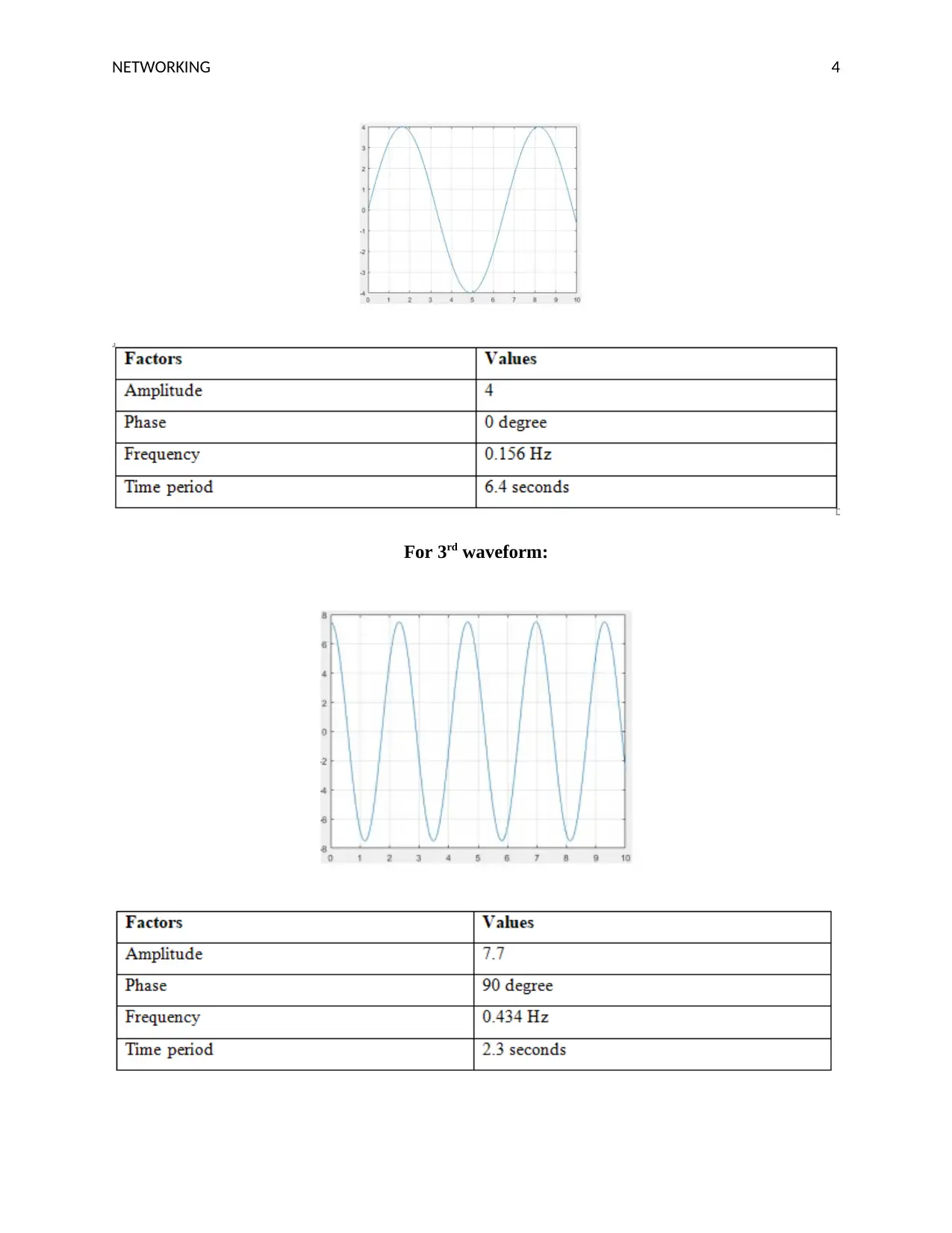
NETWORKING 4
For 3rd waveform:
For 3rd waveform:
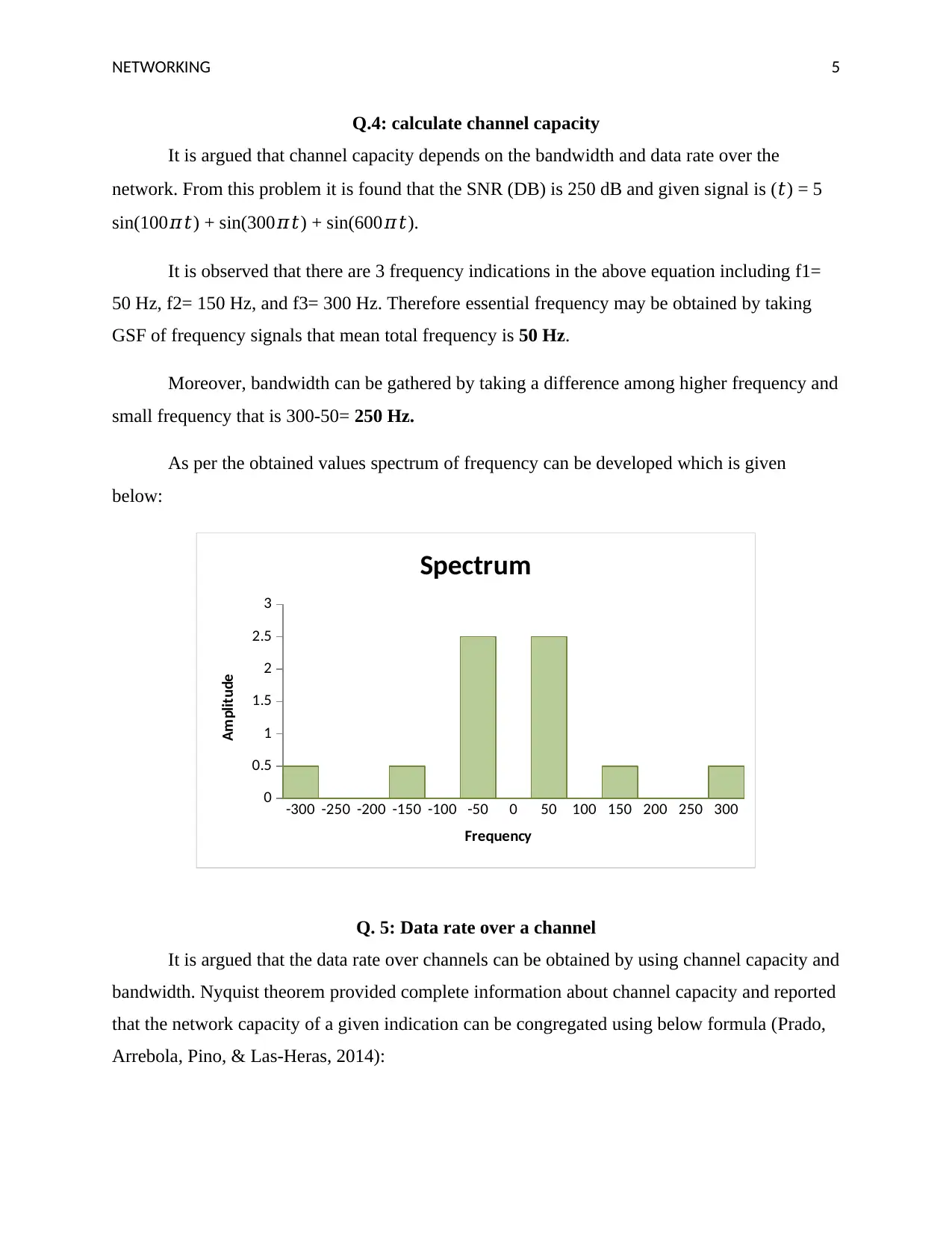
NETWORKING 5
Q.4: calculate channel capacity
It is argued that channel capacity depends on the bandwidth and data rate over the
network. From this problem it is found that the SNR (DB) is 250 dB and given signal is (𝑡) = 5
sin(100𝜋𝑡) + sin(300𝜋𝑡) + sin(600𝜋𝑡).
It is observed that there are 3 frequency indications in the above equation including f1=
50 Hz, f2= 150 Hz, and f3= 300 Hz. Therefore essential frequency may be obtained by taking
GSF of frequency signals that mean total frequency is 50 Hz.
Moreover, bandwidth can be gathered by taking a difference among higher frequency and
small frequency that is 300-50= 250 Hz.
As per the obtained values spectrum of frequency can be developed which is given
below:
-300 -250 -200 -150 -100 -50 0 50 100 150 200 250 300
0
0.5
1
1.5
2
2.5
3
Spectrum
Frequency
Amplitude
Q. 5: Data rate over a channel
It is argued that the data rate over channels can be obtained by using channel capacity and
bandwidth. Nyquist theorem provided complete information about channel capacity and reported
that the network capacity of a given indication can be congregated using below formula (Prado,
Arrebola, Pino, & Las-Heras, 2014):
Q.4: calculate channel capacity
It is argued that channel capacity depends on the bandwidth and data rate over the
network. From this problem it is found that the SNR (DB) is 250 dB and given signal is (𝑡) = 5
sin(100𝜋𝑡) + sin(300𝜋𝑡) + sin(600𝜋𝑡).
It is observed that there are 3 frequency indications in the above equation including f1=
50 Hz, f2= 150 Hz, and f3= 300 Hz. Therefore essential frequency may be obtained by taking
GSF of frequency signals that mean total frequency is 50 Hz.
Moreover, bandwidth can be gathered by taking a difference among higher frequency and
small frequency that is 300-50= 250 Hz.
As per the obtained values spectrum of frequency can be developed which is given
below:
-300 -250 -200 -150 -100 -50 0 50 100 150 200 250 300
0
0.5
1
1.5
2
2.5
3
Spectrum
Frequency
Amplitude
Q. 5: Data rate over a channel
It is argued that the data rate over channels can be obtained by using channel capacity and
bandwidth. Nyquist theorem provided complete information about channel capacity and reported
that the network capacity of a given indication can be congregated using below formula (Prado,
Arrebola, Pino, & Las-Heras, 2014):
⊘ This is a preview!⊘
Do you want full access?
Subscribe today to unlock all pages.

Trusted by 1+ million students worldwide
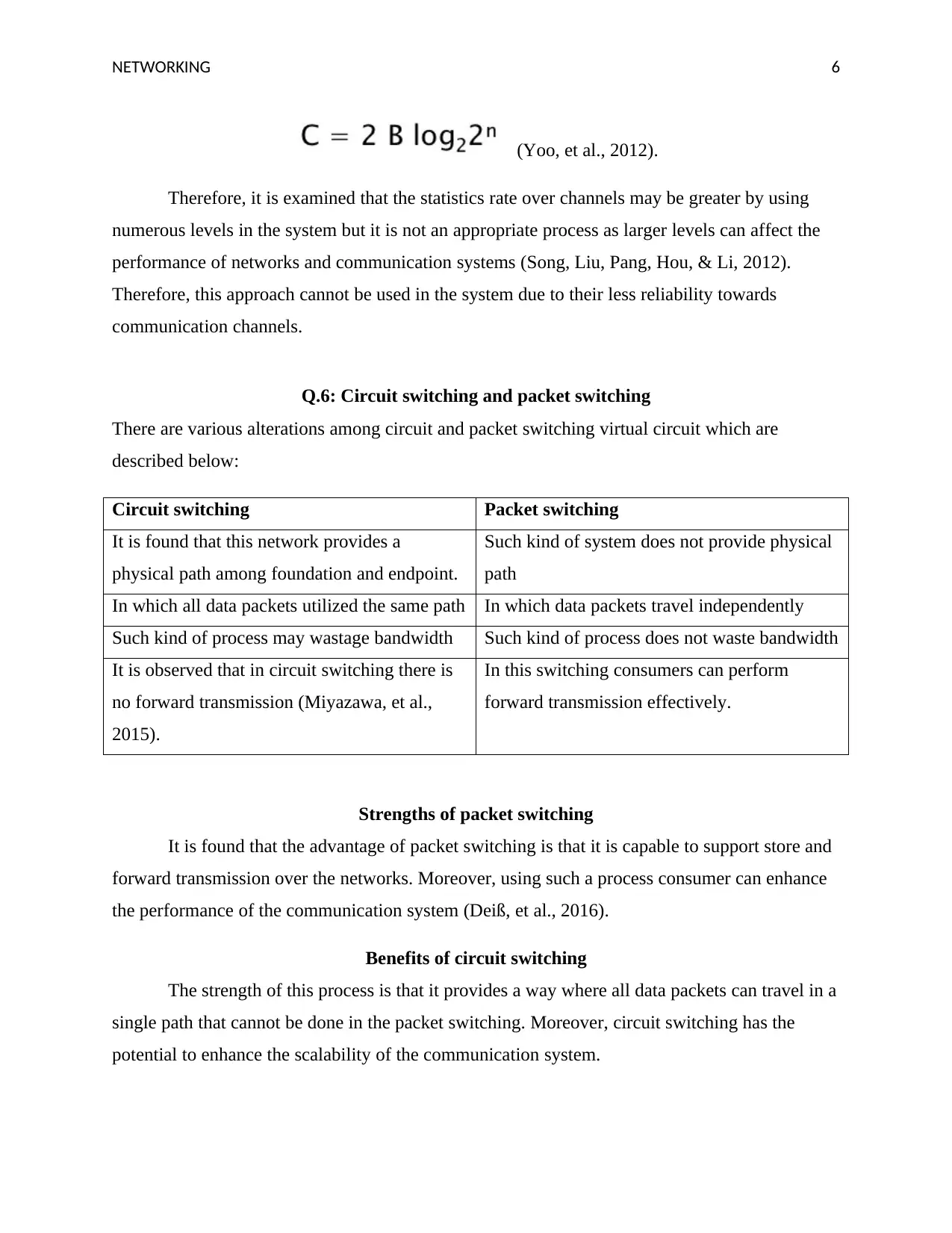
NETWORKING 6
(Yoo, et al., 2012).
Therefore, it is examined that the statistics rate over channels may be greater by using
numerous levels in the system but it is not an appropriate process as larger levels can affect the
performance of networks and communication systems (Song, Liu, Pang, Hou, & Li, 2012).
Therefore, this approach cannot be used in the system due to their less reliability towards
communication channels.
Q.6: Circuit switching and packet switching
There are various alterations among circuit and packet switching virtual circuit which are
described below:
Circuit switching Packet switching
It is found that this network provides a
physical path among foundation and endpoint.
Such kind of system does not provide physical
path
In which all data packets utilized the same path In which data packets travel independently
Such kind of process may wastage bandwidth Such kind of process does not waste bandwidth
It is observed that in circuit switching there is
no forward transmission (Miyazawa, et al.,
2015).
In this switching consumers can perform
forward transmission effectively.
Strengths of packet switching
It is found that the advantage of packet switching is that it is capable to support store and
forward transmission over the networks. Moreover, using such a process consumer can enhance
the performance of the communication system (Deiß, et al., 2016).
Benefits of circuit switching
The strength of this process is that it provides a way where all data packets can travel in a
single path that cannot be done in the packet switching. Moreover, circuit switching has the
potential to enhance the scalability of the communication system.
(Yoo, et al., 2012).
Therefore, it is examined that the statistics rate over channels may be greater by using
numerous levels in the system but it is not an appropriate process as larger levels can affect the
performance of networks and communication systems (Song, Liu, Pang, Hou, & Li, 2012).
Therefore, this approach cannot be used in the system due to their less reliability towards
communication channels.
Q.6: Circuit switching and packet switching
There are various alterations among circuit and packet switching virtual circuit which are
described below:
Circuit switching Packet switching
It is found that this network provides a
physical path among foundation and endpoint.
Such kind of system does not provide physical
path
In which all data packets utilized the same path In which data packets travel independently
Such kind of process may wastage bandwidth Such kind of process does not waste bandwidth
It is observed that in circuit switching there is
no forward transmission (Miyazawa, et al.,
2015).
In this switching consumers can perform
forward transmission effectively.
Strengths of packet switching
It is found that the advantage of packet switching is that it is capable to support store and
forward transmission over the networks. Moreover, using such a process consumer can enhance
the performance of the communication system (Deiß, et al., 2016).
Benefits of circuit switching
The strength of this process is that it provides a way where all data packets can travel in a
single path that cannot be done in the packet switching. Moreover, circuit switching has the
potential to enhance the scalability of the communication system.
Paraphrase This Document
Need a fresh take? Get an instant paraphrase of this document with our AI Paraphraser
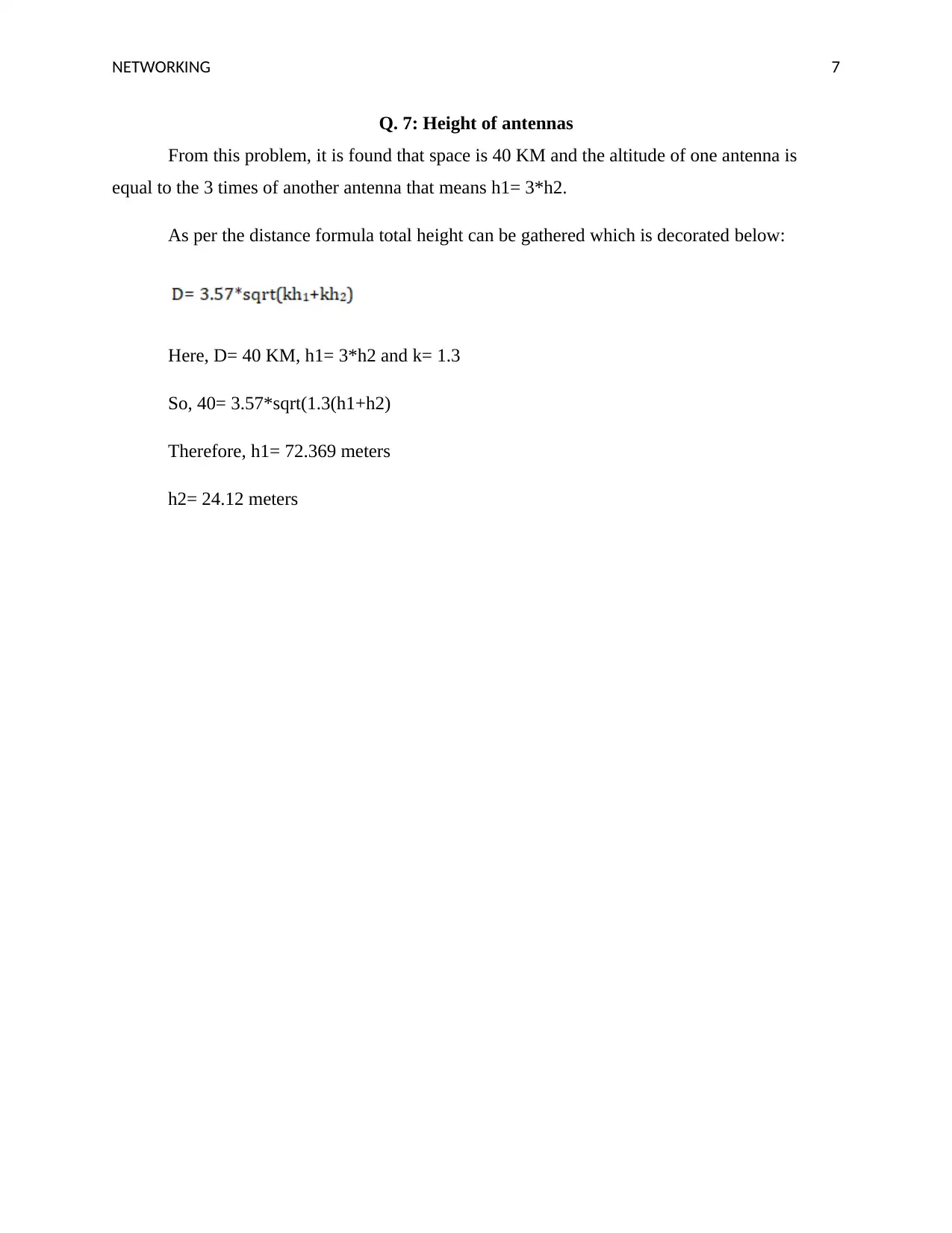
NETWORKING 7
Q. 7: Height of antennas
From this problem, it is found that space is 40 KM and the altitude of one antenna is
equal to the 3 times of another antenna that means h1= 3*h2.
As per the distance formula total height can be gathered which is decorated below:
Here, D= 40 KM, h1= 3*h2 and k= 1.3
So, 40= 3.57*sqrt(1.3(h1+h2)
Therefore, h1= 72.369 meters
h2= 24.12 meters
Q. 7: Height of antennas
From this problem, it is found that space is 40 KM and the altitude of one antenna is
equal to the 3 times of another antenna that means h1= 3*h2.
As per the distance formula total height can be gathered which is decorated below:
Here, D= 40 KM, h1= 3*h2 and k= 1.3
So, 40= 3.57*sqrt(1.3(h1+h2)
Therefore, h1= 72.369 meters
h2= 24.12 meters
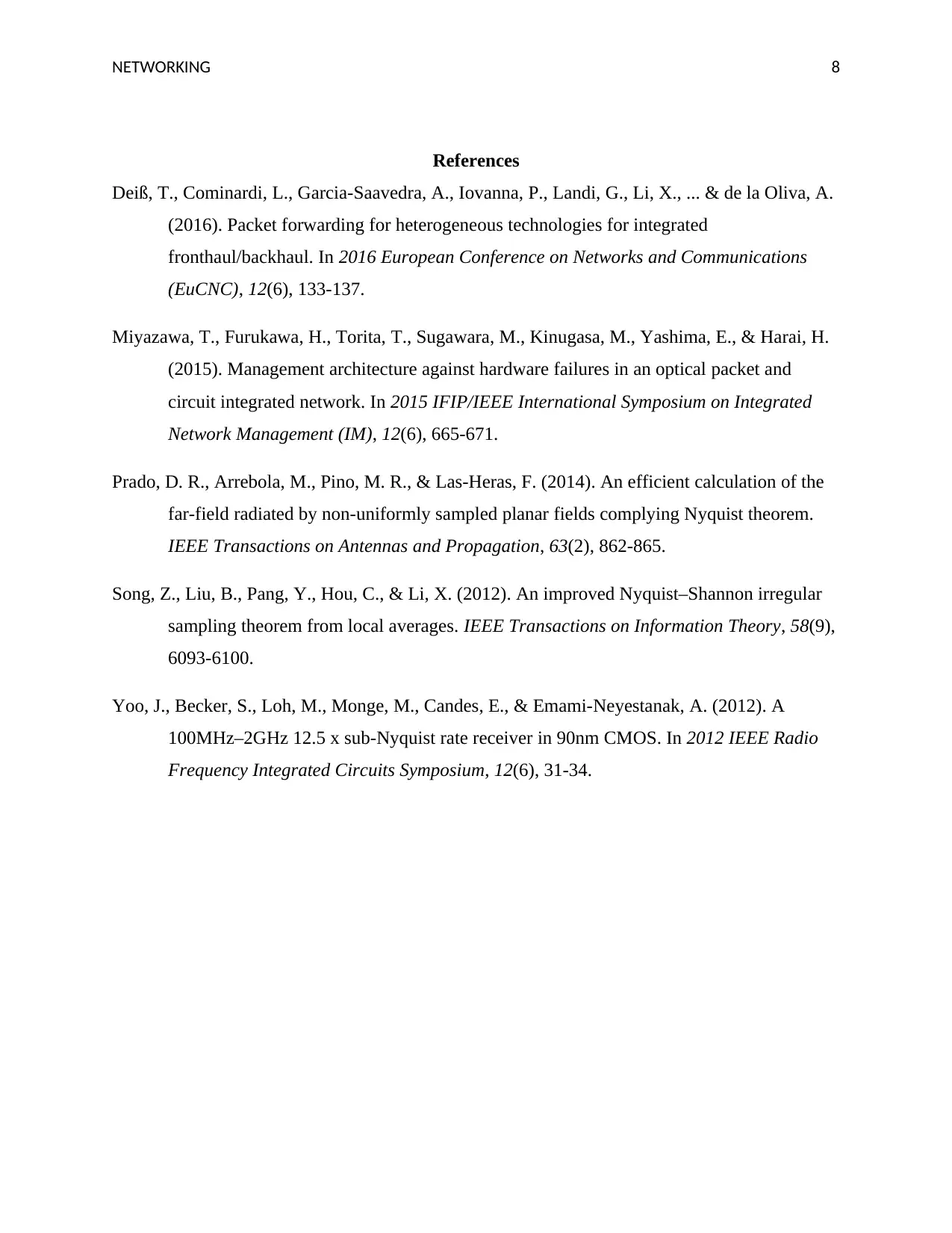
NETWORKING 8
References
Deiß, T., Cominardi, L., Garcia-Saavedra, A., Iovanna, P., Landi, G., Li, X., ... & de la Oliva, A.
(2016). Packet forwarding for heterogeneous technologies for integrated
fronthaul/backhaul. In 2016 European Conference on Networks and Communications
(EuCNC), 12(6), 133-137.
Miyazawa, T., Furukawa, H., Torita, T., Sugawara, M., Kinugasa, M., Yashima, E., & Harai, H.
(2015). Management architecture against hardware failures in an optical packet and
circuit integrated network. In 2015 IFIP/IEEE International Symposium on Integrated
Network Management (IM), 12(6), 665-671.
Prado, D. R., Arrebola, M., Pino, M. R., & Las-Heras, F. (2014). An efficient calculation of the
far-field radiated by non-uniformly sampled planar fields complying Nyquist theorem.
IEEE Transactions on Antennas and Propagation, 63(2), 862-865.
Song, Z., Liu, B., Pang, Y., Hou, C., & Li, X. (2012). An improved Nyquist–Shannon irregular
sampling theorem from local averages. IEEE Transactions on Information Theory, 58(9),
6093-6100.
Yoo, J., Becker, S., Loh, M., Monge, M., Candes, E., & Emami-Neyestanak, A. (2012). A
100MHz–2GHz 12.5 x sub-Nyquist rate receiver in 90nm CMOS. In 2012 IEEE Radio
Frequency Integrated Circuits Symposium, 12(6), 31-34.
References
Deiß, T., Cominardi, L., Garcia-Saavedra, A., Iovanna, P., Landi, G., Li, X., ... & de la Oliva, A.
(2016). Packet forwarding for heterogeneous technologies for integrated
fronthaul/backhaul. In 2016 European Conference on Networks and Communications
(EuCNC), 12(6), 133-137.
Miyazawa, T., Furukawa, H., Torita, T., Sugawara, M., Kinugasa, M., Yashima, E., & Harai, H.
(2015). Management architecture against hardware failures in an optical packet and
circuit integrated network. In 2015 IFIP/IEEE International Symposium on Integrated
Network Management (IM), 12(6), 665-671.
Prado, D. R., Arrebola, M., Pino, M. R., & Las-Heras, F. (2014). An efficient calculation of the
far-field radiated by non-uniformly sampled planar fields complying Nyquist theorem.
IEEE Transactions on Antennas and Propagation, 63(2), 862-865.
Song, Z., Liu, B., Pang, Y., Hou, C., & Li, X. (2012). An improved Nyquist–Shannon irregular
sampling theorem from local averages. IEEE Transactions on Information Theory, 58(9),
6093-6100.
Yoo, J., Becker, S., Loh, M., Monge, M., Candes, E., & Emami-Neyestanak, A. (2012). A
100MHz–2GHz 12.5 x sub-Nyquist rate receiver in 90nm CMOS. In 2012 IEEE Radio
Frequency Integrated Circuits Symposium, 12(6), 31-34.
⊘ This is a preview!⊘
Do you want full access?
Subscribe today to unlock all pages.

Trusted by 1+ million students worldwide
1 out of 9
Related Documents
Your All-in-One AI-Powered Toolkit for Academic Success.
+13062052269
info@desklib.com
Available 24*7 on WhatsApp / Email
![[object Object]](/_next/static/media/star-bottom.7253800d.svg)
Unlock your academic potential
Copyright © 2020–2025 A2Z Services. All Rights Reserved. Developed and managed by ZUCOL.




